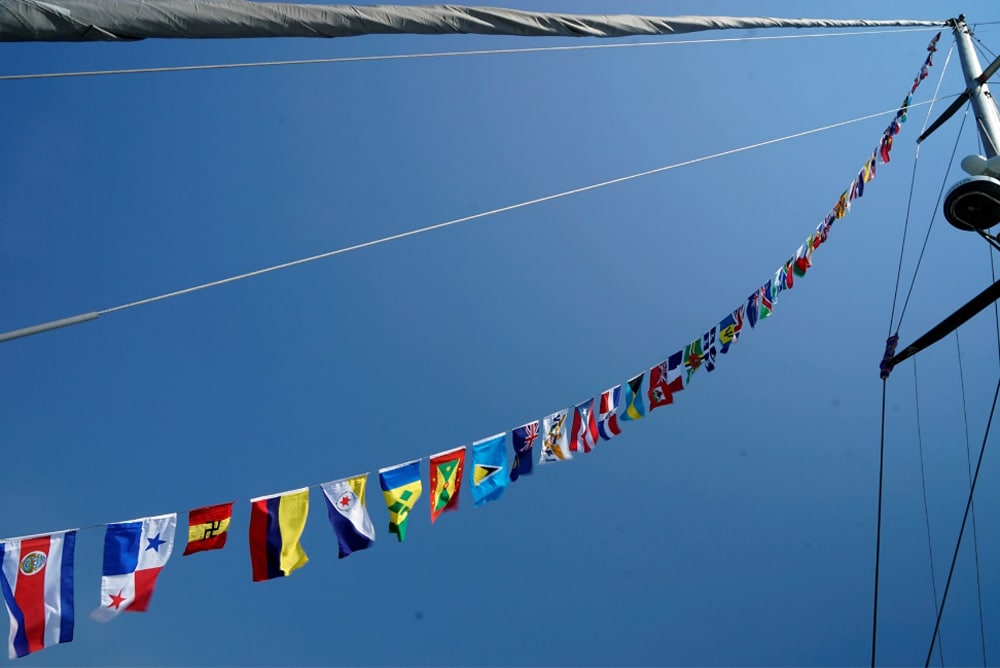
This story originally appeared on Sailing Totem.
Geeking out on flag protocol is not something I really aspired to. And yet along the way, the language of flags gained importance. I’ll never learn code signals, but the basics of proper flag etiquette show respect – and, they’re pretty simple to learn. Getting it wrong mostly just makes you look foolish, but can also invite trouble. Here are basics to help you stay courteous – and a few bonus tips.
As the name indicates, flying these is a courtesy – usually. There are some countries which require it, and may have other stipulations. For example, in Indonesia – it is required, and if you fly an ensign (your national flag) it must be smaller and lower than your Indonesian courtesy flag. Regardless of being required, it is the right and respectful practice to fly one when cleared in as a foreign vessel.
Courtesy Flag Procedure
- When: Hoist your yellow ‘Q’ flag (Q = quarantine) when crossing from international into territorial waters. You fly this (and only this, not the courtesy flag) until you have pratique (official clearance in that country).
- Where: A flag halyard on the starboard side of the main mast, up to the lowest spreader, is the right position.
- What: Courtesy flag replaces the Q flag only after clearance is complete. A courtesy flag should be unencumbered (alone) on the halyard.
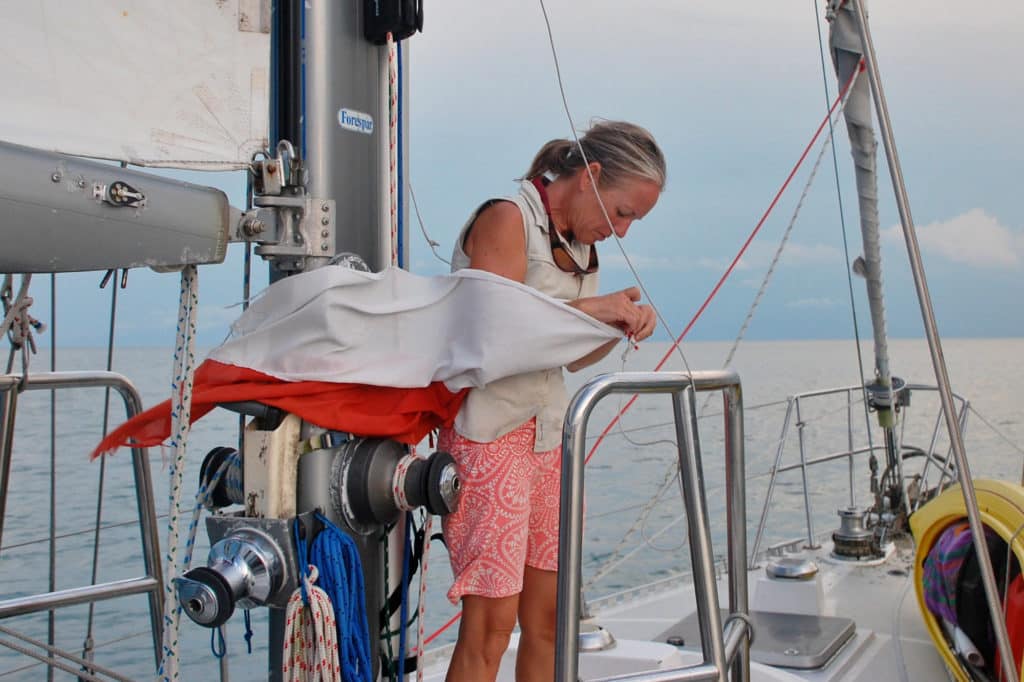
Courtesy Flag Protocol
Courtesy flags are left up 24×7.
Other flags (foreign guest, private signal, etc.) are flown on the port side.
Out of respect for our host country, we always fly a courtesy flag – unless the only one we have is so tattered it could seem offensive. We try to procure a replacement when before it shows signs of degradation.
If your boat’s layout defies any of the basics described, check Chapman Piloting. A great reference that earns the shelf space on a cruising boat!
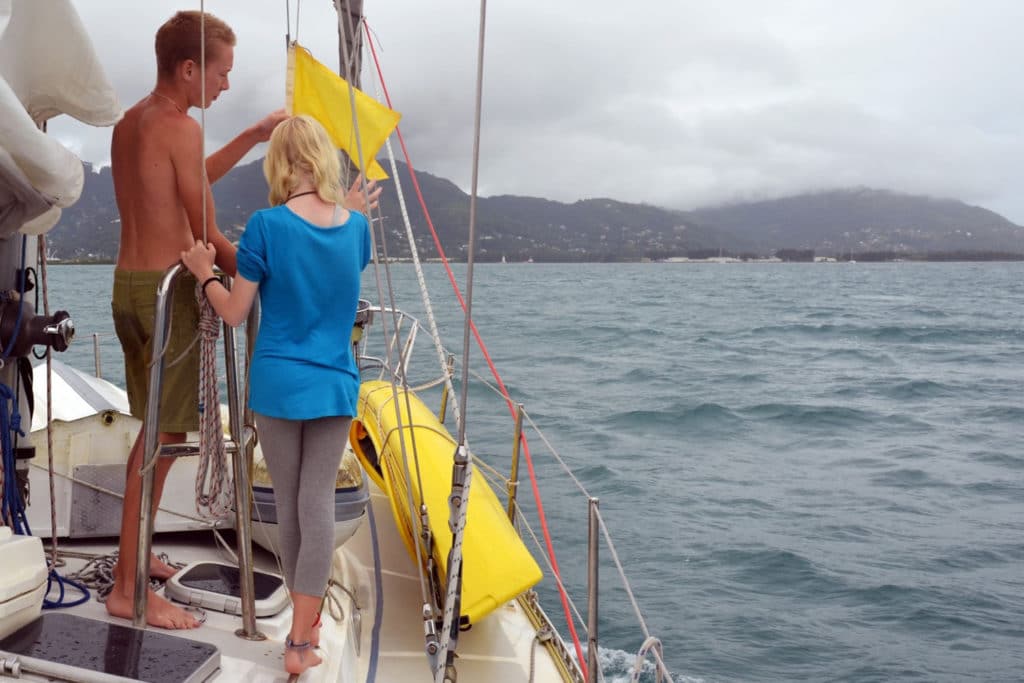
Additional Flag Protocol
When the annual cruising fleet arrives in Mexico, there are more than a handful of faux pas fluttering on the boats of newer cruisers an anchorage. The intentions are good! But poor execution can be embarrassing, or even insulting.
An upside-down flag is offensive and might be a surprisingly easy mistake depending on flag design. When we were in Comoros, we accidentally Comorian flag upside-down. It wasn’t in our books (uncommon cruising destination), and the flag lacked a handy “this way up” arrow: I found myself studying lapels on the officials to determine the yellow stripe went on top!
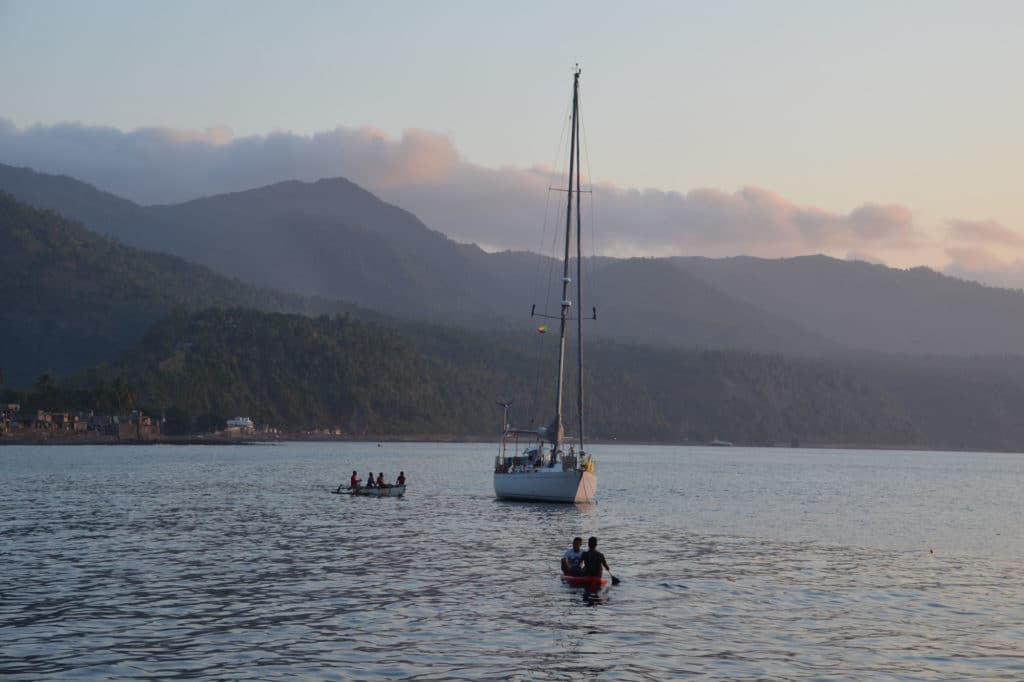
If you wish to display another flag (say, you have a guest on board from Brazil, so want to fly a Brazilian flag) this goes on the port side: not with your courtesy flag, not off the transom (reserved for the country you’re registered in). But keep in mind that the relative size of portside flags should not dwarf the courtesy flag on the starboard halyard – this may be considered offensive.
If stacking flags, order represents hierarchy: top honors go to the highest flag and descends from there. But if flying multiple foreign guest flags, alphabetical order is appropriate.
Putting one nation’s flag on top of another on the same halyard can be considered highly offensive (or an act of war) to the lower flag. Only have that one starboard halyard? Then only fly a courtesy flag, and skip the others you hoped to fly.
Make sure you have the right flag! A courtesy flag is usually the national flag of the country you’re in. In some countries, like Bahamas, they use an ensign instead; it’s similar, but not the same. Inoffensive to get wrong, but nice to get right. We missed the memo and had a national flag instead of an ensign on board, and wish we’d knonw before.
Hoisting a flag that’s 100% wrong might be an innocent mistake, but might offend your host. Our friend wondered why his Dominican Republic courtesy flag didn’t look like what other boats were flying in Dominica -oops!
When we arrived in New Caledonia, our friend Brian greeted us from his trawler, Furthur, with a word of caution. His flag provider’s bundle included the Kanak people’s New Caledonian Flag – dutifully raised post-clearance. This got him an earful from very unhappy gendarmes, who threated to fine him! (The full story on his blog, Furthur Adventures.) It’s a French territory, and flying the separatist’s flag got him into trouble; his timing with an election was poor.
Where To Get Flags
It’s helpful to buy flags in advance and have them ready for your route ahead. Flags may not be easy to find at your destination, and until sourced, you’re not… courteous!
I tend to buy ours in regional collections, for convenience and value. In recent years we started sourcing our courtesy flags from Yacht Flags as well-made flags at a good price. They’re printed on durable nylon, with the hoist reinforced and grommeted. And, it’s a boater-owned small business! Love supporting that.
For most of our cruising years, we used cheap nylon stick flags; usually just a few dollars each. Slide out the dowel (or ideally, get them sent without it!) and stitch loops on the hoist for tying onto a flag halyard. Conveniently, the 12×18″ size of those flags is exactly what suits for a courtesy flag on Totem. The downside is that they only last for a couple months: made for a desk or shelf, not the sun and wind! Still, that’s sometimes about the length of time we’ll be in a country. If we are staying longer, we could usually find a flag locally readily enough. Still – I’m glad to be onto an option that’s more durable while remaining affordable (closer to $5/flag).
The most expensive place is usually a marine chandlery, starting around $20 and going up from there. However, they can sometimes be better made: for example, Taylor flags are heavy duty Nylon and have a robust reinforcement on the hoist end, and added stitching at the fly end. It’s also a way to get the right Bahamian flag.
Some folks make their own flags. That’s too ambitious for me, although we’ve done it when necessary – including painting a Bird of Paradise on the Papua New Guinea flag I stitched together from clothing scrounged on board that happened to be the right colors.
We still want to get the most use possible out of a flag! Running a few zig-zag rows of stitching on the fly (far, vertical length) of any flag extends the life these flags. Some cruisers sew additional strips or yarn off the fly (sort of like telltales) to dampen whipping by the wind.
What About Flying An American Flag?
The notion that flying the American flag in other countries is asking for trouble because Americans are disliked has not played out in our experience. Not ever. We’ve never hidden from our national identity and never had problems (nor do I know of any cruiser that has). We also infrequently fly a US flag, but that’s because the UV wears them out so quickly and a new flag every six months is a luxury we don’t put in our budget.
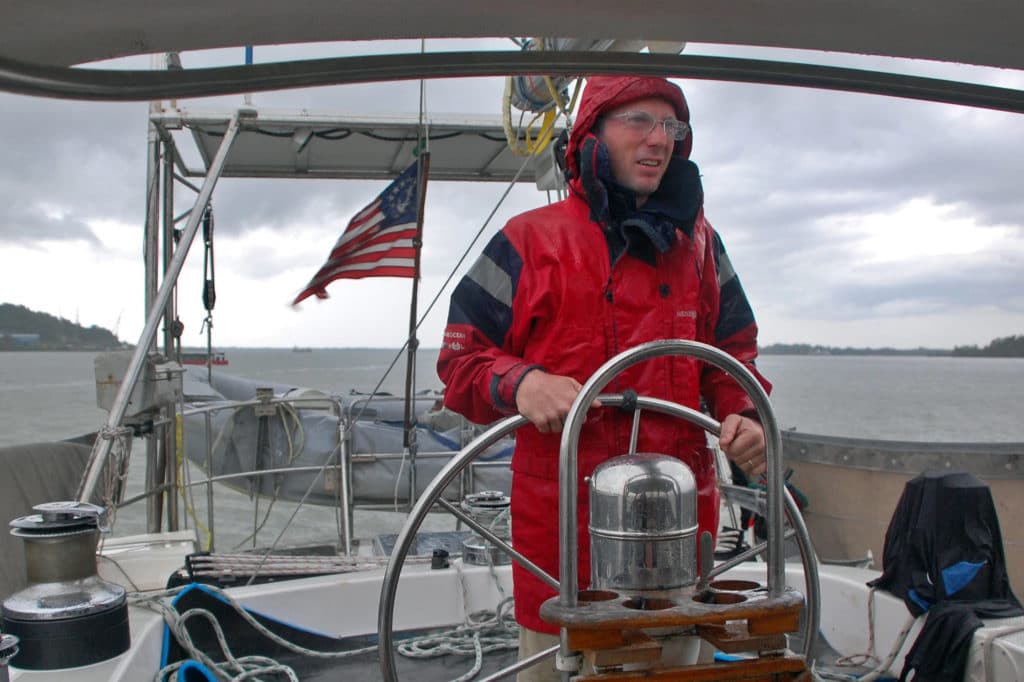
An ensign (such as our US flag above, with an anchor instead of 50 stars) is intended for flying inside the USA only. The challenge we had? Flags wore out regularly! By the time we reached Malaysia, we were down to an ensign. Buying tough flags helps! The longest-lasting on board is the “Battle Tough” flags from Gettysburg Flag.
Seeing the length of our courtesy flags strung together was a powerful feeling! And every time we clear into a new country, we have another reminder. Our tough old quarantine flag is loaded with sentimental value. It dates from the mid-80s and Jamie’s plan to sail his Sparkman & Stephens designed Sailmaster 22 to the Bahamas and beyond. Freezing weather and empty pockets thwarted his dream then, but his Q flag is nearing 40 years old and been part of Totem’s clearance process in 47 countries and territories, continuing his story on the water.








